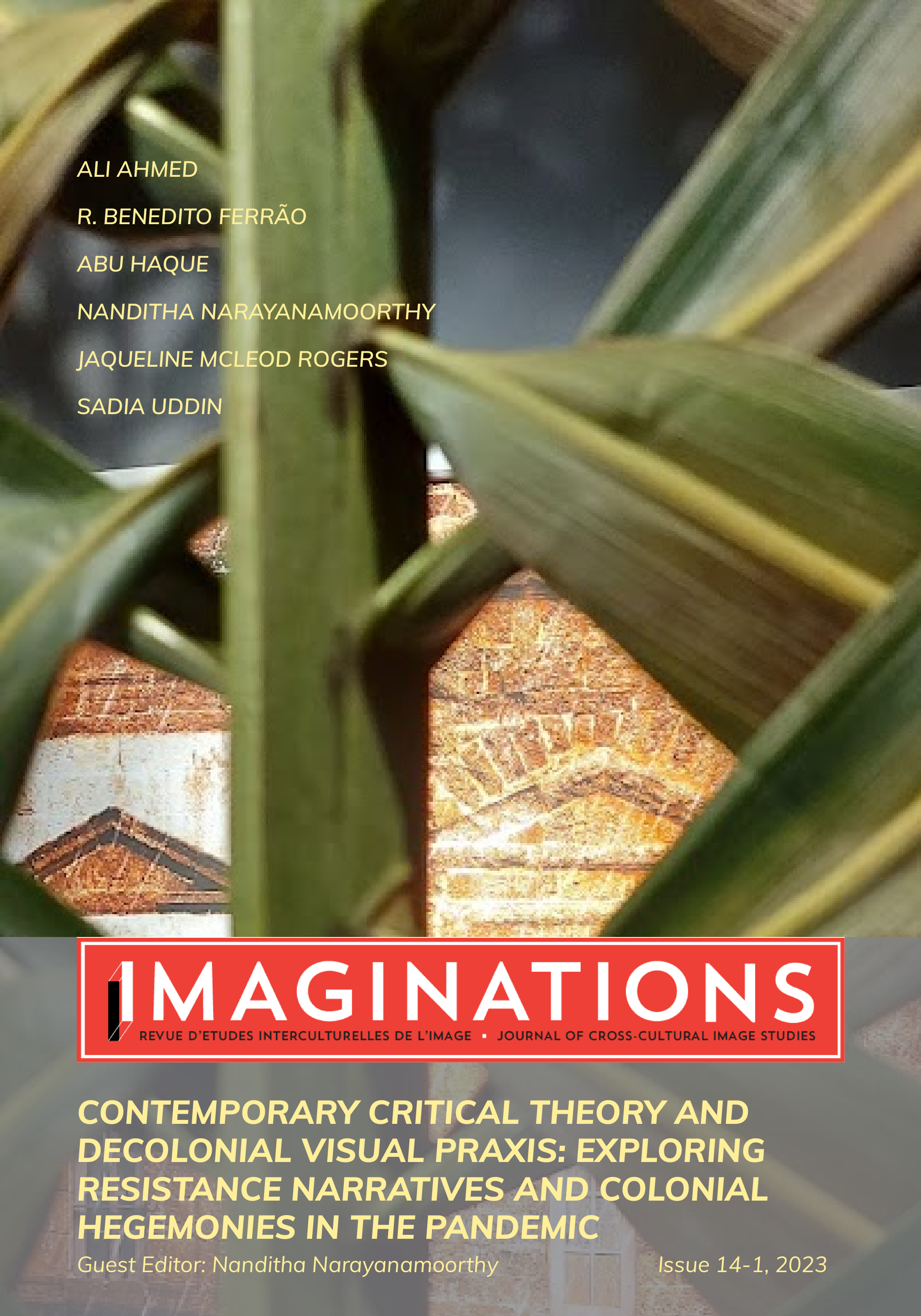Digital Resistance to Asian-American Hate during COVID-19: Study of Photography and Art on Instagram
DOI:
https://doi.org/10.17742/IMAGE29667Abstract
In this research, I study the digital resistance to Asian-American hate, isolation, alienation, and ‘othering’ visibilized during the COVID-19 pandemic in 2020-21 in the Global North. Specifically, I draw attention to the role of personal and artistic representations of Asian female bodies that perform both a resistance to hate, in the context of the pandemic, and an affirmation of ethnic and racial heritage and belonging of the self in North America. Through the engagement with #stopasianhate and #haterisavirus hashtags on Instagram, I uncover the rejection of historic and contemporary racial and gendered violence, harassment, xenophobia, and othering that emerges through visual activism and personal and artistic performativity online. I focus on the interplay between body politics and anti-racist feminist digital activism in order to understand how performativity of the self through photography and art can empower Asian-American female bodies.
References
Alpaslan, Zeynep. “Is Street Art a Crime? An Attempt at Examining Street Art Using Criminology,” Advances in Applied Sociology, vol. 2, no. 1, 2012, pp. 53-58.
Brock, André. “Black Technoculture and/as Afrofuturism.” Extrapolation, vol. 61, no. 1-2, 2020, pp. 7-28.
Butler, Judith. “Notes Towards a Performative Theory of Assembly.” Law and Literature, vol. 30, no. 2, Harvard UP, 2018, p. 381.
Caldeira, Sofia P., et al. “‘Everybody Needs to Post a Selfie Every Once in a While’: Exploring the Politics of Instagram Curation in Young Women’s Self-Representational Practices.” Information, Communication & Society, vol. 24, no. 8, Routledge, 2021, pp. 1073-90, doi:10.1080/1369118X.2020.1776371.
Collins, Patricia Hill, and Sirma Bilge. Intersectionality. Polity Press, 2016.
Corrigall-Brown, Catherine, and Rima Wilkes. “Picturing Protest: The Visual Framing of Collective Action by First Nations in Canada.” American Behavioral Scientist, vol. 56, no. 2, Feb. 2012, pp. 223-243, doi:10.1177/0002764211419357.
Demos, TJ. “Between Rebel Creativity and Reification: For and Against Visual Activism.” Journal of visual culture 15.1 (2016): 85–102. Web.
Devakumar, Delan, et al. “COVID-19: The Great Unequaliser.” Journal of the Royal Society of Medicine, vol. 113, no. 6, June 2020, pp. 234–235, doi:10.1177/0141076820925434.
Fraser, Nancy. “Rethinking the Public Sphere: A Contribution to the Critique of Actually Existing Democracy.” Social Text, no. 25/26, Duke University Press, 1990, pp. 56–80, https://doi.org/10.2307/466240.
Gover, Angela R., et al. “Anti-Asian Hate Crime During the COVID-19 Pandemic: Exploring the Reproduction of Inequality.” American Journal of Criminal Justice, vol. 45, no. 4, 2020, pp. 647–67, doi:10.1007/s12103-020-09545-1.
Grosz, Elizabeth. “The Future of Feminist Theory: Dreams for New Knowledges.” Becoming Undone. New York, USA: Duke University Press, 2020. 74–87. Web.
Jenzen, Olu, et al. “The Symbol of Social Media in Contemporary Protest: Twitter and the Gezi Park Movement.” Convergence (London, England), vol. 27, no. 2, SAGE Publications, 2021, pp. 414–37, doi:10.1177/1354856520933747.
Jeung, R. “Incidents of coronavirus discrimination : A report for A3PCON and CAA.” Asian Pacific Policy and Planning Council. 2020. DOI: http://www.asianpacificpolicyandplanningcouncil.org/wp-content/uploads/Stop_AAPI_Hate_Weekly_Report_4_3_20.pdf.
Kang, Xin, Wenyin Chen, and Jian Kang. 2019. “Art in the Age of Social Media: Interaction Behavior Analysis of Instagram Art Accounts” Informatics 6. 4(2019): 52-. https://doi.org/10.3390/informatics6040052.
Kilgo, Danielle K. & Rachel R. Mourão. “Protest Coverage Matters: How Media Framing and Visual Communication Affects Support for Black Civil Rights Protests,” Mass Communication and Society, 24:4, 576-596, 2021, DOI: 10.1080/15205436.2021.1884724.
Le, Thomas K., et al. “Anti-Asian Xenophobia and Asian American COVID-19 Disparities.” American Journal of Public Health (1971), vol. 110, no. 9, 2020, pp. 1371–73, doi:10.2105/AJPH.2020.305846.
Lee, Jennifer. “Asian Americans, Affirmative Action & the Rise in Anti-Asian Hate.” Daedalus (Cambridge, Mass.), vol. 150, no. 2, American Academy of Arts and Sciences, 2021, pp. 180–98, doi:10.1162/daed_a_01854.
Li, Yao, and Harvey L. Nicholson. “When ‘model Minorities’ Become ‘yellow peril’—Othering and the Racialization of Asian Americans in the COVID‐19 Pandemic.” Sociology Compass, vol. 15, no. 2, Wiley Subscription Services, Inc, 2021, p. e12849–n/a, doi:10.1111/soc4.12849.
Lotfalian, Mazyar. “Aestheticized Politics, Visual Culture, and Emergent Forms of Digital Practice.” International Journal of Communication (Online), University of Southern California, Annenberg School for Communication & Journalism, Annenberg Press, 2013, p. 1371–1390.
Manovich, L. Instagram and contemporary image. New York, 2017. DOI: http://manovich.net/index.php/projects/ Instagram-and-contemporary-image.
McGarry, A., I. Erhart, H. Eslen-Ziya, O.Jenzen, U. Korkut (eds), The Aesthetics of Global Protest: Visual Culture and Communication. Amsterdam: Amsterdam University Press, 2020, DOI: 10.5117/9789463724913_pre.
Nakamura, Lisa. “Watching White Supremacy on Digital Video Platforms: ‘Screw Your Optics, I’m Going In.’” Film quarterly 72.3 (2019): 19–22. Web.
Piancatelli, Chiara, Marta Massi, and Andrea Vocino. “Artoninstagram: Engaging with Art in the Era of the Selfie.” International journal of market research 63.2 (2021): 134-160. Web.
Ren, Jingqiu, and Joe Feagin. “Face Mask Symbolism in Anti-Asian Hate Crimes.” Ethnic and Racial Studies, vol. 44, no. 5, Routledge, 2021, pp. 746–58, doi:10.1080/01419870.2020.1826553.
Senft, T. M., & Baym, N. K. “What does the selfie say? Investigating a global phenomenon.” International Journal of Communication, 9 (2015): 1588–1606,. https://ijoc.org/index.php/ijoc/article/ view/4067/1387
Silva, Armando. “Imaginaries In Contemporary Aesthetics” Imaginations 7:2 (2017): 174-187. DOI: 10.17742/IMAGE.VOS.7-2.10.
Sliwinska, Basia. Feminist Visual Activism and the Body. Routledge, 2021.
Taş, Oĝuzhan, and Tuĝba Taş. “Resistance on the Walls, Reclaiming Public Space: Street Art in Times of Political Turmoil in Turkey.” Interactions (Bristol, England), vol. 5, no. 3, Intellect, 2014, pp. 327–49, doi:10.1386/iscc.5.3.327_1.
Emiliano Treré. Hybrid Media Activism: Ecologies, Imaginaries, Algorithms. Taylor and Francis, 2018. Web.
Published
How to Cite
Issue
Section
License
Copyright (c) 2023 Narayanamoorthy Nanditha

This work is licensed under a Creative Commons Attribution-NonCommercial-NoDerivatives 4.0 International License.

This work by https://journals.library.ualberta.ca/imaginations is licensed under a Creative Commons 4.0 International License although certain works referenced herein may be separately licensed, or the author has exercised their right to fair dealing under the Canadian Copyright Act.




